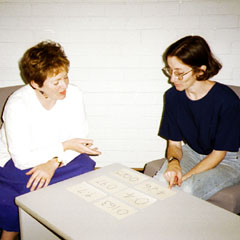|
 Introduction Introduction
Maria reads decimals in the conventional way (digit point digit
digit). She has a good idea of the size of 4.26 but doesn't understand
the meaning of additional digits (e.g. as in 4.261)
Comments: Text in italics
Interviewer: Text in red
Maria: Text other colour
Interviewer:
Could you please read out the numbers on these cards? |

Maria:
Oh point 4 |

Maria:
nine point seven |

Maria:
Oh point one six three |

Maria:
Oh point oh two five |

Maria:
Oh point nine seven |

Maria:
Four point two six |

Interviewer:
If your children came home from school and
said they had trouble understanding decimals, what could you say
to help them? How could you explain four point two six?
Maria:
Well there are 4 whole numbers and then
the extras are decimals. It would be about 4 and a quarter...just
over.
Interviewer:
Just over?
Maria:
Yes, 25 is a quarter.
Interviewer:
When you were at school, did your teacher
use names for the columns after the decimal point? |

Maria:
I think that maybe is the tenths and... |

Maria:
...that is the umm hundredths, yes hundredths.
Interviewer:
What if I write a one on the end of that number? |

Maria:
Well, you only need to look at the first
2 places, like money, so it would be $4 and 26 cents. You can ignore
the rest of the decimals if it's too long...umm, I think we called
it "rounding". Like when a calculator gives you a long answer but
you can ignore the last numbers.
Maria disregards any digits beyond the hundredths column.
|










 Introduction
Introduction